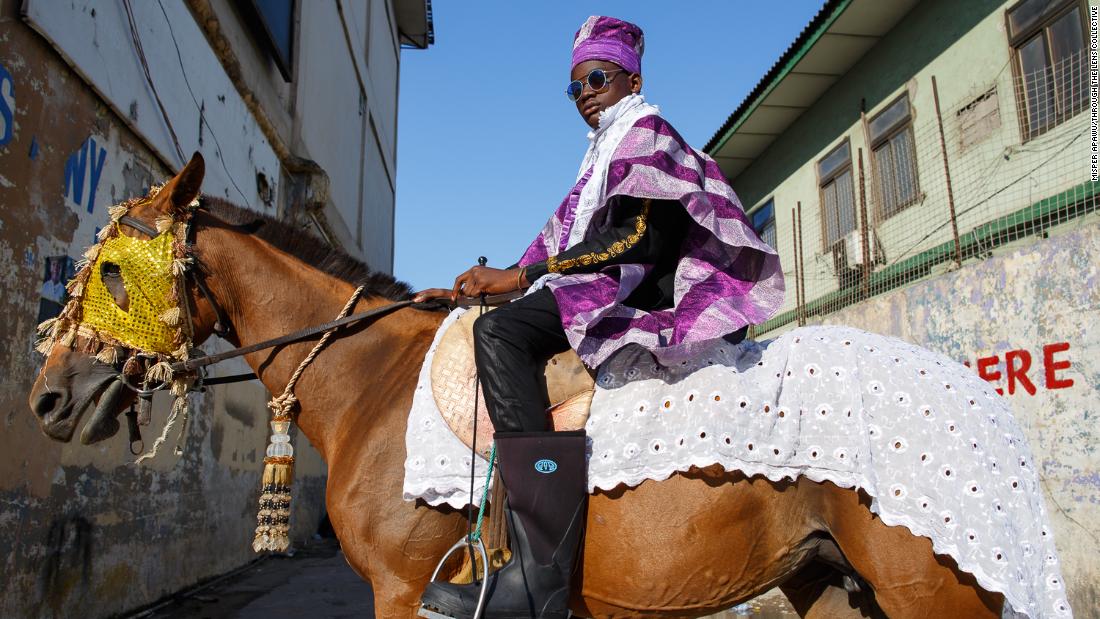Written by Rochelle Beighton, CNN
These days, you can’t avoid seeing pictures from your friends’ vacations on Instagram or Facebook, but not so long ago, the most common way to see the world was on a postcard.
From the late 19th century to the early 20th century, when international travel was less commonplace, postcards were a crucial window to the wider world for many people. But in much the same way that social media can be used to spread misinformation, postcards would also be used to promote a particular agenda.
During this period, much of Africa was under European rule and postcards played a significant role in how the continent was perceived internationally. Many postcards showed Africa through the lens of visiting soldiers, missionaries, or professional photographers, resulting in visual caricatures of the continent that persist to this day.
This undated postcard shows Bornu warriors in ceremonial battle dress. The Bornu Empire (1380-1893) encompassed territory that’s now part of Nigeria, Niger, Chad and Cameroon. Credit: Historia/Shutterstock
Now “Post-Card Africa” is working to redesign the history of postcards on the continent. The project is a global call out from South African photographers Michelle Loukidis and Michelle Harris, co-founders of Through The Lens Collective, a Johannesburg-based photography school.
A new wave of African postcards
Focusing predominantly on the history of Africa and African photography, the collective supports students by helping them capture their stories and perspectives on the continent.
They asked people to respond to the colonial history of postcards by submitting images they believe represent their country and people today. Since launching in May, they have received over 3,000 entries from 38 of Africa’s 54 countries, offering a wide overview of contemporary life in the continent.
The idea for Post-Card Africa was formed after Loukidis and Harris gave a lesson exploring the history of African photography, which revealed misrepresentations in old postcards. They felt there was a global conversation yet to be had about the inaccuracies and the frustrations these postcards perpetuated.
“For us, it’s a response to a history that is still very much alive and prevalent — to these singular images that were sent all around the world during the colonial era, which were giving a one-sided view of things, but also very stereotypical views, very exotic views,” Harris said.
This image from “Post-Card Africa” by Amina Kadous shows a group of street cleaners at a coffee shop in Old Cairo. Credit: Amina Kadous/ Through the Lens Collective
Outdated images
According to Vivian Bickford-Smith, a professor of historical studies at the University of Cape Town, postcards circulated of sub-Saharan Africa during European colonial rule typically fall into two major categories.
The first are those that captured missionary work, intending to show how colonial missionaries were “civilizing” Africa. These typically featured white missionaries in a background that demonstrates conversion taking place, such as a school setting where children are holding hands with nuns.
“The Africans who I think are notably absent are Black Africans, indigenous Africans — those who have already been educated, already are perhaps professionals or teachers themselves,” Bickford-Smith said.
The second category is postcards that portray “un-Westernized” Africa. These would have been created by the colonizing project to imply their work was needed.
“They may show school kids being taught, but in a ramshackle building. Or there might be a rickety thatched hut with a cross on the top suggesting ‘We need a church.’ Basically, the message will be, ‘We need money,'” Bickford-Smith said.
This undated postcard shows traditional Malagasy houses in Mahajanga, Madagascar. Credit: Historia/Shutterstock
In this period, when hundreds of thousands of postcards were sent every year, Bickford-Smith says they contributed to creating a global image of Africa. Africans were portrayed in postcards largely as tribespeople in indigenous dress or — if they were women — photographed semi-naked, suggesting they required Christianization.
“There is a tendency with postcards to look for differences, and exoticize. The danger here is you don’t see people going about their ordinary lives,” Bickford-Smith said.
Although colonial postcards have long gone out of circulation, Loukidis believes Africa continues to be misrepresented in modern imagery. She says Google images of Africa will show sunsets and safari animals first and foremost. But the submissions they have received from their callout show a different side of the continent, ranging from vibrant portraits of people in their everyday environments to images spotlighting urban settings.
“We’re doing completely normal things. We’re cooking, we’re walking in the streets, we’re getting dressed up really fashionably, we’re swimming in the sea,” Loukidis said.
This photo from “Post-Card Africa” shows “a young woman spending time in her garden, connecting to nature,” according to Nomonde Kananda, who captured the image in Gauteng, South Africa. Credit: Nomonde Kanada /Through the Lens Collective
Harris agreed: “I think it’s incredibly important that we have these everyday views and scenes, particularly because of what you see on the internet. In my years of teaching photography, I’ve often had, particularly American students, come and ask, “So where are the lions and where are the elephants in the street?” she said.
In the long term, Through the Lens Collective foresees Post-Card Africa as an archive, offering a rounded perception of Africa that can act as a framework for educational spaces worldwide.
“It’s important for African photographers to begin to take hold of our representation and change global perceptions of Africa,” Harris said.
Images from the project will be exhibited for the first time in 2023 at LagosPhoto, an international contemporary photography festival held annually in Nigeria.

































